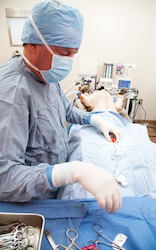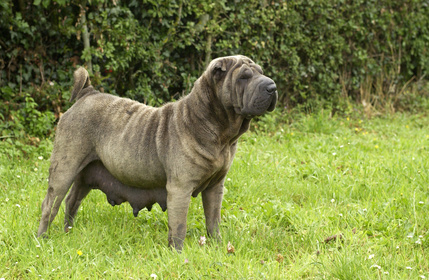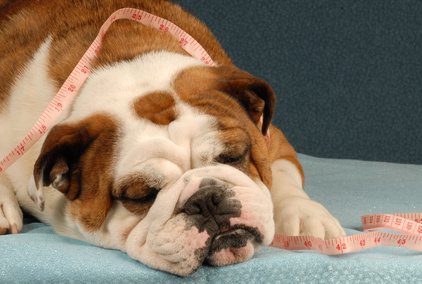Sterilization of the bitch
 The sterilization will allow, not only, to exclude any risk of unwanted reproduction but also to avoid the disadvantages associated with the heat in the dog (blood loss, behavior change, onslaught of male dogs…).
The sterilization will allow, not only, to exclude any risk of unwanted reproduction but also to avoid the disadvantages associated with the heat in the dog (blood loss, behavior change, onslaught of male dogs…).
Other advantages are associated with ovariectomy, This particularly as surgery is carried out early.
AS IS-THIS-THAT OVARIECTOMY ?
Oophorectomy is a procedure that involves removing both ovaries of a dog.
It requires a General anesthesia.
Your pet will therefore usually kept at the clinic one day : you will be asked to bring your pet on an empty stomach in the morning. The operation will be performed in the morning and your dog will be returned to you, well awakened, the evening.
Both techniques can be used:
– Ovariectomy by the white line (the scar of the intervention will be at the level of the belly of the animal)
– Ovariectomy the flanks (the veterinarian using in this case access to the abdomen through the flanks of the animal)
At the Veterinary Clinic of Kreiz Breizh, We practice this intervention by the white line (except rare exceptions), and under gas anesthesia.
WHY DO STERILIZE MY BITCH ?
Sterilization of this bitch serious benefits:
§ Removal of heat :
Ovariectomy will allow to remove periods of heat and blood loss that accompany them. You should know that in a bitch not sterilized, sexual cycles are present throughout the animal's life (There is no menopause in the bitch).
§ In a household comprising several bitches :
Sterilization can have an interest in the management of certain behavioural disorders including homes where coexist more bitches:
The hormonal cycle changes the perception of the status of an animal in the Pack, giving rise to situations of confrontation and competition between different females. Sterilization (and therefore the removal of the heat) allows a more harmonious coexistence and restricts cases of aggression between bitches.
§ In the case of hereditary disease
Sterilization to prevent the reproduction of animals suffering from hereditary diseases.
§ Preventive role in several pathologies
¤ Ovariectomy limit the risk ofuterine infection.
¤ It also prevents the emergence of any Ovarian Tumor because the ovaries are removed during surgery.
¤ Some bitches tend to make of pseudo-gestation lactations (or nerve pregnancies) : they behave as if they expected the small and secrete even milk. This disorder tends a repeat in some females after each period of heat.
Ovariectomy prevents recurrence of these "nervous pregnancy" (surgery may be performed after medical treatment to stop lactation)
The operation is all the more interesting that repeated and poorly cared pseudo-gestation lactations promote mammary tumours.
¤ Finally, many studies have proven that the sterilization of a young slut very significantly decreased the risk of developing mammary tumors later. Knowing that the mammary tumors represent one of the most common cancers in the bitch, This benefit is non-negligible.
Sterilization of the dog may present possible disadvantages, much lower compared to the benefits of the intervention.
– Weight gain is possible after the intervention.
– A very low number of bitches will develop a so-called incontinence "castration" (especially bitches of some large breeds such as Boxer, Bobtail, Rottweiler or Dobermann)
Tailored solutions exist :
– Your veterinarian will advise you on the power to give to a sterilized pet. An appropriate diet will prevent any weight gain after surgery.
– Most exciting of castration respond well to medical treatment.
Do not hesitate to ask your veterinarian any questions concerning items that could worry to be fully reassured before surgery.
AT WHAT AGE MUST I BE STERILIZED MY BITCH ?
The ideal age for the sterilization of a dog lies before his first heat (heats begin generally to 6 months in small breeds, worms 12 or even 18 months in giant breeds). Your vet will tell you the best time to practice the intervention.
Prevention of mammary tumors is maximum when the dog is sterilized before his first heat (where no hormonal impregnation des mamelles has yet occurred)
The benefit of the intervention then gradually decreases as the dog ages:
– The risk of developing mammary tumors 0,05% in a bitch sterilized before his first heat compared to a dog not sterilized
– It's 8% in a bitch sterilized between its first and second season
– Then 26% After the second heat
– Beyond 36 month, more no decrease in tumor risk was noted compared to the risk of developing a breast tumor in a dog not sterilized.
STERILIZATION AS A TREATMENT
Even in a old bitch having not been sterilized, ovariectomy (removal of the ovaries) or the out (removal of the ovaries and the uterus) may become necessary for medical reasons:
– Duringdisorders of the uterus an ovariohysterectomy must be carried out:
This is the case in congenital uterine anomalies, from uterine tumor, polyps, uterine hemorrhage, from pyometra (uterine infection), but twisting or uterine rupture.
– When mammary tumors :
In some cancers of the breasts, the breast tissue is hormone receptor-rich. Hormonal changes related to the heat will then tend to increase the speed of development of cancer or cause recurrence even after removal of the mammary masses.
In these cases, the fact of sterilize the animal In addition to the removal of the tumor will greatly reduce the risk of recidivism and strongly increase the life expectancy of the bitch (These bitches have an average duration of survival 45% superior to those of unsterilized dogs)
– Finally, oophorectomy can indirectly help better manage some pathologies:
When endocrine disease (for example for Diabetes), each hormonal change linked to the cycle of the bitch tends a interfere with medical treatment received by the animal. Sterilization of the bitch will allow to remove these drawbacks and so better treat disease.
§
Sterilization of the bitch has so very many interests. The benefits of the intervention are even more interesting that the operation is performed in a young bitch.
The ideal age of sterilization is located shortly before the first heats of the animal.
This article is protected by copyright © Vetup


